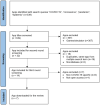COVID-19 Mobile Health Apps: An Overview of Mobile Applications in Indonesia
- PMID: 35602145
- PMCID: PMC9114306
- DOI: 10.3389/fpubh.2022.879695
COVID-19 Mobile Health Apps: An Overview of Mobile Applications in Indonesia
Abstract
Background: Mobile health applications (mHealth apps) have been widely used for various purposes for mitigating the COVID-19 pandemic, such as self-assessment, contact tracing, disseminating information, minimizing exposure, and reducing face-to-face health consultation. The objective of this study is to systematically review COVID-19 related mHealth apps and highlight gaps to inform the development of future mHealth initiatives in Indonesia.
Methods: A systematic search strategy using a PRISMA flowchart was used to identify mHealth apps available in Google Play and Apple Play stores. We searched mHealth apps using certain specific terms related to COVID-19 outbreaks. The inclusion criteria were apps-based smartphone users related to COVID-19 using local language, free of cost, available in the Google Play and Apple Play Stores, and supported by the Indonesian government. We excluded games, apps on infectious diseases unrelated to COVID-19 specifically, and apps with non-Bahasa Indonesia (Indonesian language). The selected mHealth apps were assessed based on two measures: (1) the WHO guidelines on digital health intervention and (2) the four dimensions of the mHealth technology fit framework. In addition, user feedback from experienced and non-experienced users was conducted to evaluate four dimensions of the apps.
Results: A total of 339 mHealth apps were generated from the initial search, remaining seven selected apps that met inclusion criteria. The results highlighted that mHealth apps reviewed had still not been widely used by the general public. The applications were purposed to disseminate information, conduct a self-risk assessment, provide an online community forum, and telemedicine or teleconsultation regarding COVID-19. Data services, including data storage, aggregation, and data exchange, are available in most apps. The rarest function found was contact tracing and assisting health management and health workers, such as the availability of testing facilities, reporting test results, and prescribing medication. The main issues reported were the lack of data security and data privacy protection, integration and infrastructures, usability, and usefulness.
Conclusion: Our study highlighted the necessity to improve mHealth apps' functions related to assisting health workers and the function of digital contact tracing. An effort to increase public awareness regarding the use of mHealth is also necessary to streamline the function of this innovation. Policymakers must consider usefulness, usability, integration, and infrastructure issues to improve their mHealth function.
Keywords: COVID-19; Indonesia; Indonesia COVID-19; mHealth apps; pandemic; public healthcare.
Copyright © 2022 Sujarwoto, Augia, Dahlan, Sahputri, Holipah and Maharani.
Conflict of interest statement
The authors declare that the research was conducted in the absence of any commercial or financial relationships that could be construed as a potential conflict of interest.
Figures
References
-
- Tambo E, Kazienga A, Talla M, Chengho CF, Fotsing C. Digital technology, and mobile applications impact on Zika and Ebola epidemics data sharing and emergency response. J Health Med Informat. (2017) 8:254. 10.4172/2157-7420.1000254 - DOI
Publication types
MeSH terms
LinkOut - more resources
Full Text Sources
Medical
Miscellaneous



